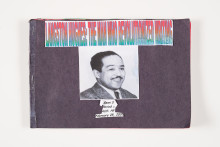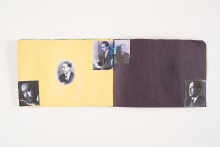Sean D. Henry-Smith’s Body Text transmits a visceral investigation into blackness and space through word-riffs and photographic plays of psyche. The mode of inquiry positioned within the work drives forth physical responses to metaphysical questions: “Here am I,” Body Text first posits, like Samuel speaking forth to the Lord at night—but who is this “I” in the here-ness in which one finds oneself? The work is heady, yet of the soil. There is no image, Body Text relates, without the “I” and we must deal with this “I” as a body, as a human being.
Lucas de Lima selected Body Text for this year’s New Delta Review chapbook prize. Below, a conversation with Sean D. Henry-Smith conducted and edited by John Rufo.
– – –

 John Rufo: When did you first encounter poetry?
John Rufo: When did you first encounter poetry?
Sean D. Henry Smith: In third grade, I was assigned to do a project on Langston Hughes during Black History Month. My sister worked at the school library, so she gave me one of his books. I read his work and made a little booklet for the project.
JR: So Body Text isn’t your first work; you were making chapbooks in the third grade!
SDHS: Yeah, in some way!
JR: Did you have any poetry in your house?
SDHS: We lived a fifteen-minute walk from the library, so I would go every week and check out fifty books, which was the limit. For Christmas, my mom would give us African folklore books. My sister sometimes returned home with books labeled “to be discarded” from the library, all of which were related to blackness in some way. My mom also provided us with encyclopedias. I went through those all the time, like chapter-books. I would just read “A.” Everyone in my family had their own Bible; additionally, there was at least one Bible in every room. Somehow, we were always acquiring new Bibles. My mom would call me into her room and we would work through passages of the Bible together. I read the entire Bible multiple times as a kid, which isn’t to say I understood everything, but I sincerely wanted to be an expert by the time I grew up.
“The process of arranging words and shooting film are inseparable for me.”
JR: It’s interesting that you grew up surrounded by text. Your poems insist on their status as poem, as printed movements of language. “The murder encircles or, a whiff of every spider” includes a line about watching the poems in this collection “grow up so fast.”
SDHS: I think my work now is more comfortable with the classification “poem.” When I first started seriously writing poetry, I thought of my poems as re-interpretations of artist statements, or series of words as they related to a visual artwork. My ideas behind the poems involved writing among a body of already-existing art images. Now, I identify as a poet, a photographer, and an artist, all at once. Even though I was trained as a photographer, the process of arranging words and shooting film are inseparable for me. My poems are visual. “Onslaught” is like a brick wall. “Of One’s Own” is intended to be an overwhelming visual projection. Similarly, my self-portrait, where the earth is devouring me, operates as a visual mass. All of these pieces are singing the same song. They are means to a similar end.
JR: Do you think that end is accomplished?
SDHS: For this chapbook the end has been accomplished, but I haven’t resolved the “Body Text problem” yet. I’m dealing with racially-charged paranoia. This paranoia consists of one’s positionality in the world in a broad sense, but also in walking down the street, being completely alone, not knowing whether you have complete control of your body. I’m still trying to figure out an aesthetics/poetics. There’s no one voice in the chapbook, purposefully. It’s in surround sound! Usually my ideas come from conversation snippets. I’ll place the ideas on Twitter to get quick reactions to those verbal fragments. Twitter becomes my workshop. After all, the original title for Body Text was Internet Mom God. Those three words loom over the work. The work isn’t just about the Internet, my mom, or God, but these “forces” or “beings” inform how I move through the world. When I speak about “the world” I mean a physical and digital space.
JR: The Internet not only functions as your workshop, but often as a site of education and protest, right? You’ve engaged many times with the Mongrel Coalition Against Gringpo (MCAG), for example.
SDHS: To visual arts people, I’ve had to explain over and over what MCAG represents. There isn’t anything like MCAG in the visual arts, except for maybe the Guerilla Girls, but in terms of being organized digitally and resisting incorporation, MCAG might stand alone. For some reason, when you engage with something digitally, it doesn’t seem “legitimate.” This is a continual consideration in my work. I’m negotiating the print formation as it’s translated online. I’ve read things online that “feel real” to me: it’s just that the teardrop is on my laptop instead of on the page. I’m intrigued by the power of language and visuals that don’t necessarily demand a specific medium. Yes, I want a book to hold, but I think a poem doing good and real work will do that work whether it’s on your phone or in a chapbook.
“My poetic response came from anger, birthed of fear, but it wasn’t entirely anger or fear.”
JR: We’ve talked about “text”—let’s address the first part of your chapbook title: “body.”
SDHS: Most of my work involves human-ness and bodies. A quick example: the photograms in the book are presentations of my hair. More generally, I’m drawn to the question of who is allowed to be a human. “Human” and “body” are synonymous for me. Who’s allowed to fully be a body? The majority of the work in Body Text was written with that question in mind. “[ENTER YELLOW SUN],” for example, is not what I would call a compassionate work, but it was written the day after the shootings in South Carolina, and was, weirdly, the only way I could respond to that event. My response was more than simply anger: that particular instance of violence against black people shook me up in a real way: that could’ve been my family. My poetic response came from anger, birthed of fear, but it wasn’t entirely anger or fear. Pissing your bed, which is the instance activating that poem, isn’t a moment of strength or genuine anger, but when it’s written in all-caps, as that poem is, the expected emotion is subverted. I’m trying to own up to my fear firmly.
JR: Did you sequence the poems in Body Text according to their balance of emotions?
SDHS: I think about my poems geographically. When I consider the structure of Body Text, I understand the poems inhabiting specific places. “Onslaught” takes place on a hike, “Of One’s Own” happens in an archive or a library, “[ENTER YELLOW SUN]” revolves around a bedroom, and “Extension” is a house. These are the spaces where one recognizes how one’s body is operating. Black bodies are reduced to news stories: to just being dead bodies. My work is trying to carve out a space for a response to that representation of bodies. When is your body your own? When are you fully human?
JR: When did you begin thinking more about spaces?
SDHS: The spatial awareness occurred when I moved away from college. I’m far more aware of my positionality now, even while walking to work every day. Honestly, I’m still figuring out how to translate and work through that feeling of black bodies in space, of my body in space. I wasn’t trained as a poet, so I’m still figuring out how to explore that question. The only English class I ever took in college was “Queers of Color.”
“I’m interested in a black critique of the work.”
JR: Do you feel like you’re exploring queerness?
SDHS: Not overtly, but it’s present in the work. My “black authorship” stamp is more intentional. Body Text presents an exploration through black lexicon. I wanted to invent moments where I could pull from pop culture and academia at the same time, as they’re both under my black umbrella. Blackness holds a prominent position to indicate the audience for the work. I fear that my work will mostly be engaged with or endorsed by a white audience. I’m interested in a black critique of the work. After all, nearly all of the poets I read are engaged with questions of blackness: Aimé Césaire, Fred Moten, Dawn Lundy Martin, Douglas Kearney, Morgan Parker, among others. All of their voices are guides to what I’m working towards.
Sean D. Henry-Smith is a poet and photographer intrigued by their intersections. Originally from Miami, he is currently based in Syracuse, NY, serving as the Communications Coordinator at Light Work. His debut chapbook Body Text is now available from NDR. You can find him online at seanhenrysmith.com and on Twitter and Instagram.
John Rufo‘s work has been previously published or is forthcoming from Academy of American Poets, Ploughshares, Entropy, Fanzine, and Jacket 2. This fall, he will begin graduate study in English literature at the University of California, Riverside. You can find him online at dadtalkshow.tumblr.com.